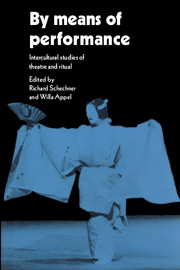Book contents
- Frontmatter
- Contents
- List of figures
- Notes on contributors
- Concerning Victor Turner
- Introduction
- 1 Are there universals of performance in myth, ritual, and drama?
- 2 Magnitudes of performance
- 3 Liminality: a synthesis of subjective and objective experience
- 4 The Yaqui deer dance at Pascua Pueblo, Arizona
- 5 A Yaqui point of view: on Yaqui ceremonies and anthropologists
- 6 Performance of precepts/precepts of performance: Hasidic celebrations of Purim in Brooklyn
- 7 The significance of performance for its audience: an analysis of three Sri Lankan rituals
- 8 What does it mean to “become the character”: power, presence, and transcendence in Asian in-body disciplines of practice
- 9 Korean shamans: role playing through trance possession
- 10 The practice of noh theatre
- 11 The profanation of the sacred in circus clown performances
- 12 Ethnographic notes on sacred and profane performance
- 13 The spatial sense of the sacred in Spanish America and the American South and its tie with performance
- 14 Space and context
- 15 The transformation of consciousness in ritual performances: some thoughts and questions
- 16 Universals of performance; or amortizing play
- Appendix
- Bibliography
- Index
8 - What does it mean to “become the character”: power, presence, and transcendence in Asian in-body disciplines of practice
Published online by Cambridge University Press: 05 June 2012
- Frontmatter
- Contents
- List of figures
- Notes on contributors
- Concerning Victor Turner
- Introduction
- 1 Are there universals of performance in myth, ritual, and drama?
- 2 Magnitudes of performance
- 3 Liminality: a synthesis of subjective and objective experience
- 4 The Yaqui deer dance at Pascua Pueblo, Arizona
- 5 A Yaqui point of view: on Yaqui ceremonies and anthropologists
- 6 Performance of precepts/precepts of performance: Hasidic celebrations of Purim in Brooklyn
- 7 The significance of performance for its audience: an analysis of three Sri Lankan rituals
- 8 What does it mean to “become the character”: power, presence, and transcendence in Asian in-body disciplines of practice
- 9 Korean shamans: role playing through trance possession
- 10 The practice of noh theatre
- 11 The profanation of the sacred in circus clown performances
- 12 Ethnographic notes on sacred and profane performance
- 13 The spatial sense of the sacred in Spanish America and the American South and its tie with performance
- 14 Space and context
- 15 The transformation of consciousness in ritual performances: some thoughts and questions
- 16 Universals of performance; or amortizing play
- Appendix
- Bibliography
- Index
Summary
Hearing an Asian actor say that in performance he “becomes the character” is a response very like what a Western actor might say. But in spite of the similarity, I've long been bothered by the fact that there has been little discussion in the literature of exactly what the Asian actor means. For the Indian kathakali or Japanese noh actor, “becoming the character” is a statement which epitomizes (1) the lifelong process of training and (2) the immediate psychophysical process of engaging in performing (doing) the acts which constitute a performance on any given occasion. The entire disciplined path is a gradual interweaving of external techniques and internal processes.
Over the past seven years I have been studying, practicing, and researching various “in-body” disciplines of Asian meditational, martial, and performing arts. These disciplines share many assumptions, principles, and details of practice. Primary is the fact that daily repetition of physical exercises and/or performance techniques encodes the techniques in the body. By daily practice all physical and mental obstacles in the way of correct practice are gradually eliminated. The goal of all such virtuosic systems is reaching a state of “accomplishment” (Skt., siddhi) in which the doer and done are one. Through such actualized practice comes both control and transcendence of “self.”
- Type
- Chapter
- Information
- By Means of PerformanceIntercultural Studies of Theatre and Ritual, pp. 131 - 148Publisher: Cambridge University PressPrint publication year: 1990
- 23
- Cited by



